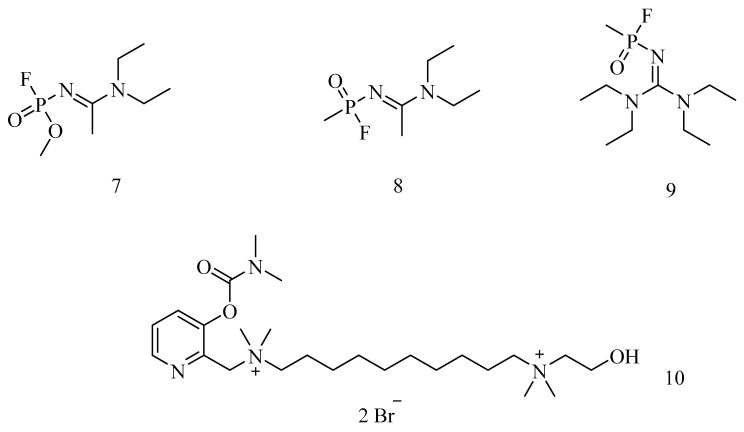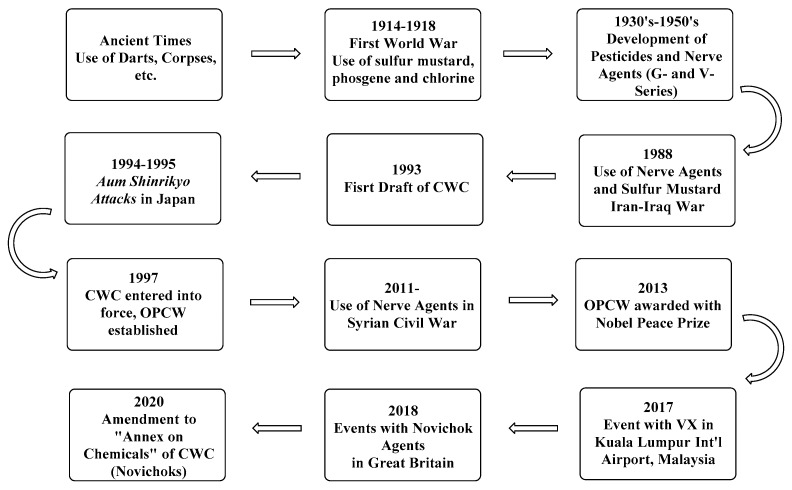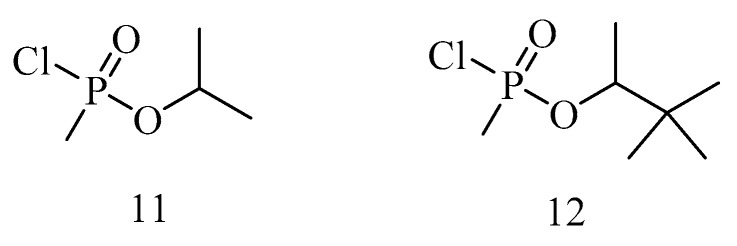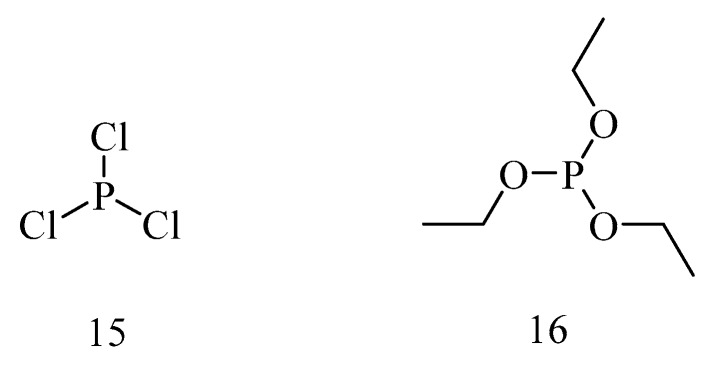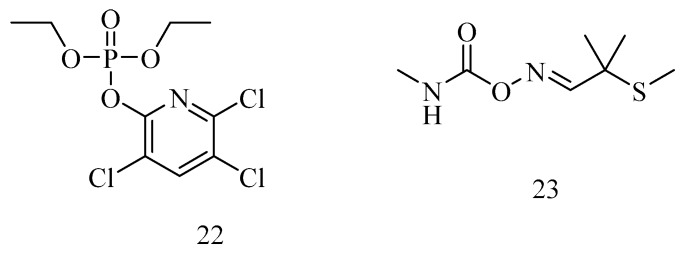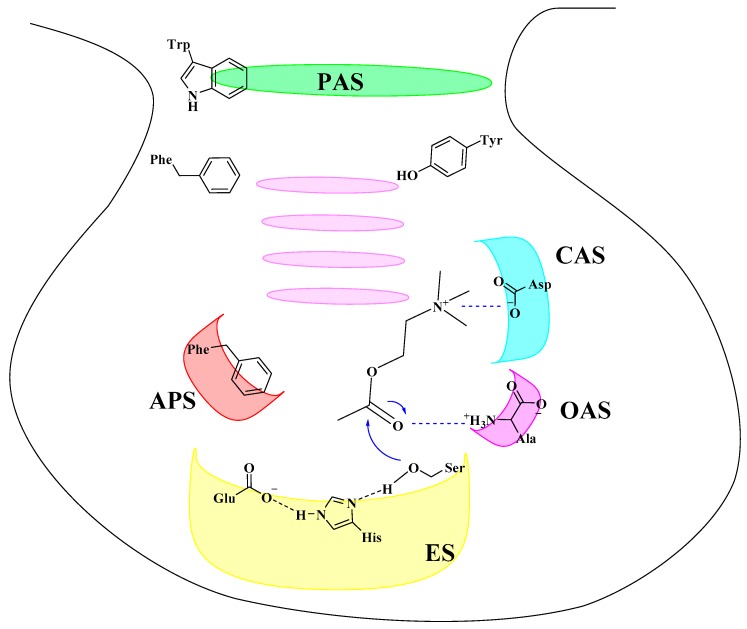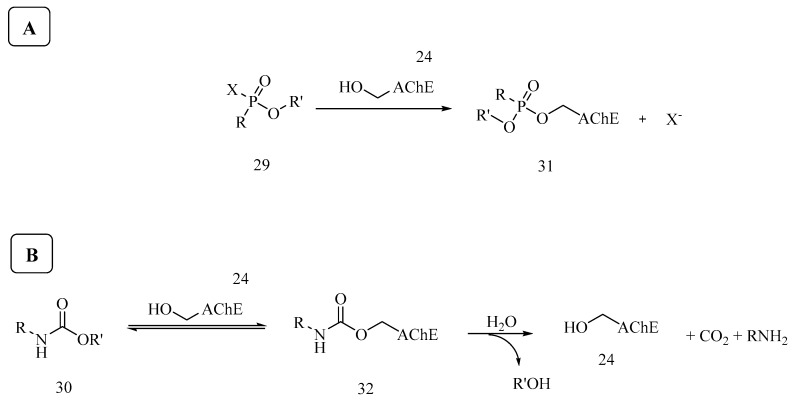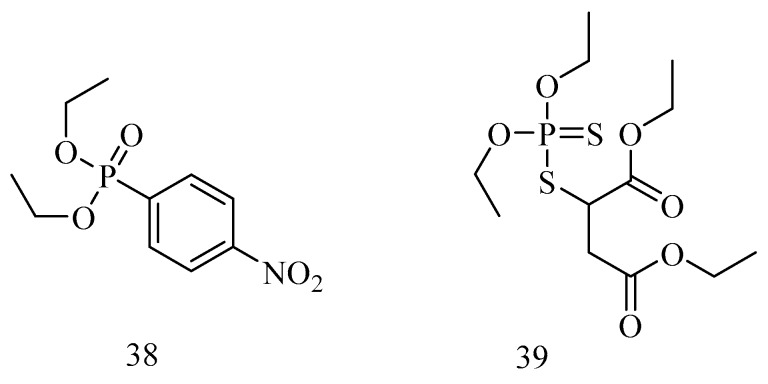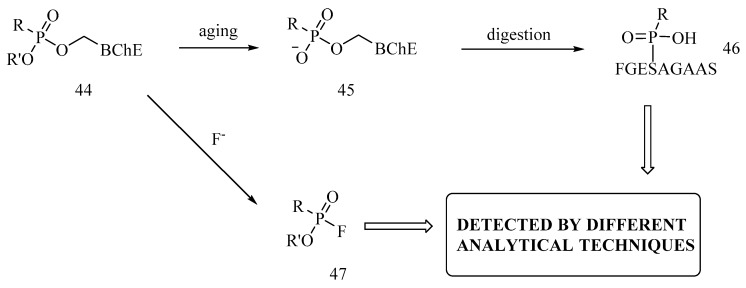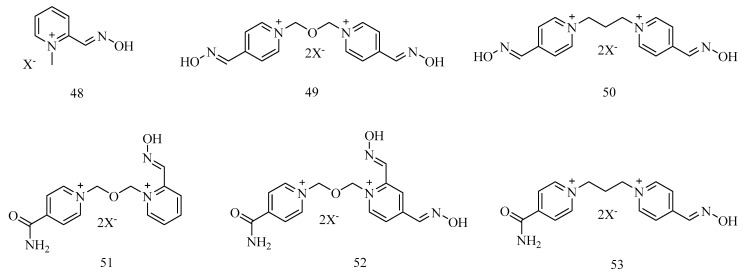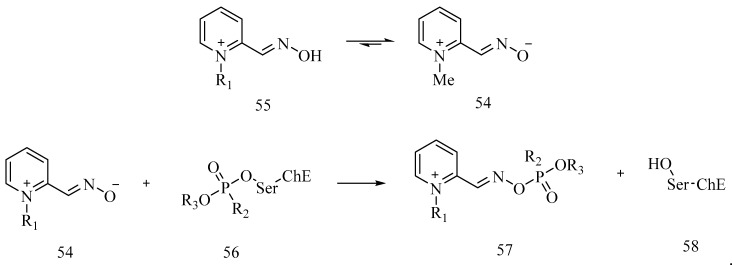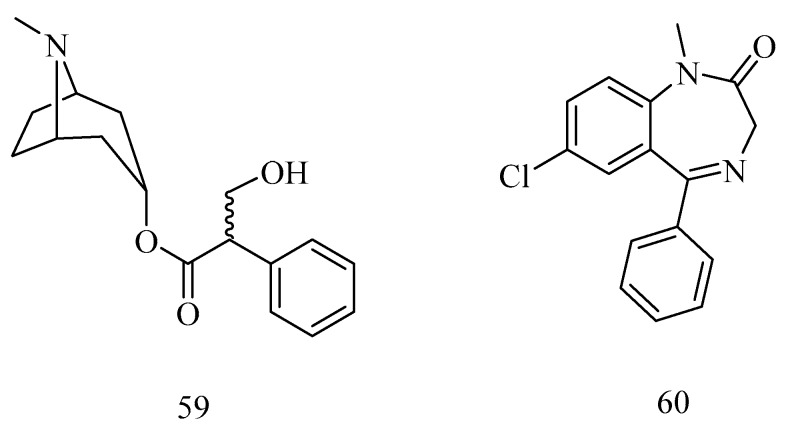Abstract
This article describes acetylcholinesterase (AChE), an enzyme involved in parasympathetic neurotransmission, its activity, and how its inhibition can be pharmacologically useful for treating dementia, caused by Alzheimer’s disease, or as a warfare method due to the action of nerve agents. The chemical concepts related to the irreversible inhibition of AChE, its reactivation, and aging are discussed, along with a relationship to the current international legislation on chemical weapons.
Keywords: acetylcholinesterase, Alzheimer’s disease, nerve agents, Chemical Weapons Convention
1. Introduction
The use of chemical weapons (CW) is quite common throughout history. Over time, the use of incendiaries, darts, spears, and arrows impregnated with poisons from different organisms, animals, and plants, the lethality of substances used for warfare have been dramatically improved. Despite international agreements already in existence by the end of 19th century, these did not inhibit the large-scale use of CW during World War I (WWI) (1914–1918), when millions of casualties were provoked mainly by phosgene, chlorine, and, particularly, sulfur mustard (HD 1) (Figure 1). This compound, due to its physicochemical characteristics, is known as “area denial weapon”, precluding further access to the place where it has been deployed [1].
Figure 1.
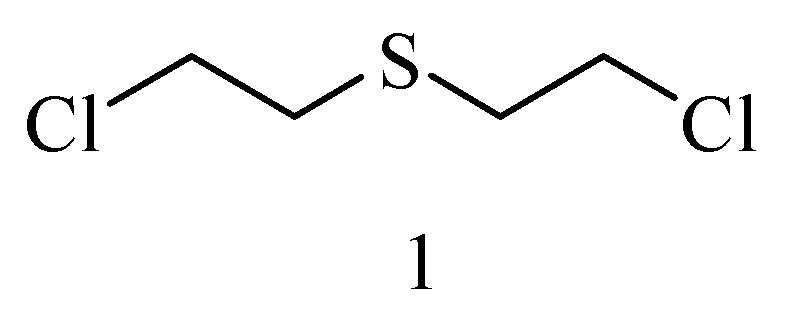
Sulfur mustard HD1.
After WWI and more actively during WWII, while looking for new pesticides, German scientists developed a series of pentavalent phosphorus compounds that contained a leaving group such as a halogen. They discovered that these compounds were very toxic, and capable of inhibiting acetylcholinesterase (AChE). These findings resulted in the weaponization of the first nerve agents, called also G-agents, which included sarin 2 (GB), soman 3 (GD), and tabun 4 (GA) (Figure 2). Such CW were produced and stockpiled, but never used during WWII [1,2,3,4,5,6,7,8,9,10,11].
Figure 2.
G-Agents.
Later, during the 1950s, aiming to produce more effective pesticides, groups in the former Soviet Union, Great Britain, Sweden, and the United States developed other organophosphorus compounds which were more toxic and persistent (less volatile) than G-agents. These new chemicals were then named V-agents, which are phosphonothioates (5 and 6, Figure 3) [4,12,13,14,15]. Like sulfur mustard HD 1, these compounds can be similarly regarded as “area denial weapons” [2,8].
Figure 3.
V-Agents.
Although they were not used in the World Wars, the international community could soon testify their potential as Weapons of Mass Destruction (WMD) when, in the 1980s, Saddam Hussein’s troops used chemical artillery containing G-agents, GB 2 and GA 4, along with sulfur mustard HD 1, against civilian and military targets during the Iran–Iraq war. The tragic events in the Kurdish city of Halabja show how abhorrent can be the use of these substances as warfare agents [16,17,18]. In 1994 and 1995, Japan was stricken by two episodes when GB 2 was employed in the terrorist actions carried out by the sect Aum Shinrikyo, provoking casualties among civilians and first responders [4,19,20,21,22].
Although many papers have dealt with chemical warfare over the years, the use of CW is currently a pressing subject. Recently, chemical warfare agents have made headlines due to their alleged deployment in the Civil War ongoing in Syria (2011–) and as means of murdering the North Korean national Kim Jun Nam at the Kuala Lumpur International Airport in 2017. A report from Malaysian authorities confirmed that VX was used by the perpetrators [4,23,24,25,26,27,28,29,30,31,32,33,34,35,36,37,38,39,40,41,42].
In 2018, events that occurred in Salisbury and Amesbury, Great Britain, where a former Russian agent and other people were poisoned with an “unknown, high-purity grade military agent” with possible neurotoxic effects, prompted discussions about the so-called “Novichok” agents. These then elusive compounds are predicted to act similarly to known nerve agents, but with higher toxicity and different physicochemical properties, for example, being solid at room temperature. After discussions on the actual structures of the Novichok agents, the most important agreement on chemical disarmament, the Chemical Weapons Convention (CWC), has acknowledged four novel scaffolds in its “Annex on Chemicals”, which are to be entered into force in June 2020. Figure 4 depicts examples of these compounds (7–10) [4,43,44,45,46,47,48,49,50].
Figure 4.
Some considered structures for Novichok Agents according to the Chemical Weapons Convention (CWC).
From pharmacological and toxicological points of view, the biological targets of classical (G- and V-) and “Novichok” nerve agents are the cholinesterases, a class of enzymes involved in a myriad of biological processes, such as respiration, cognition, and drug metabolism. Cholinesterases are found in two isoforms, AChE (EC 3.1.1.7) and butyrylcholinesterase (BChE), EC 3.1.1.8. Compounds that can inhibit cholinesterases may impact the body positively or negatively and, therefore, be either explored as method of warfare or therapeutically [51,52,53,54,55,56,57,58,59,60,61,62,63,64,65,66,67].
Herein, we review the inhibition of cholinesterases and their outcome and how these chemical reactions can be subject of interest in the treatment of neurodegenerative diseases, like Alzheimer’s disease (AD) or as method of warfare, which is forbidden by the CWC.
2. The Chemical Weapons Convention
After many international agreements have sought to forbid the use of toxic chemicals as a mode of warfare, the Chemical Weapons Convention (CWC) entered into force in 1997, paving the way for the creation of the Organization for the Prohibition of Chemical Weapons (OPCW), the international watchdog responsible for overseeing the implementation of the CWC. The headquarters are located in The Hague, The Netherlands. As of January 2020, there are 193 signatories or State Parties to the CWC. In accordance to OPCW website, “98% of the global population lives under the protection of the Convention” and “97% of the chemical weapons stockpiles declared by possessor States have been verifiably destroyed” [1,3]. A short timeline of events using chemical warfare agents and the CWC can be devised. Although OPCW has made efforts throughout years to eliminate CW, which have granted it the Nobel Peace Prize in 2013 [1,2,6,68], the world has witnessed their recurrent use in conflicts or terrorism (Chart 1).
Chart 1.
Non-comprehensive timeline of the CWC and use of chemical warfare (CW).
In the preamble of the CWC, the State Parties are called out to ensure “that the complete and effective prohibition of the development, production, acquisition, stockpiling, retention, transfer and use of chemical weapons, and their destruction, represent a necessary step towards the achievement of these common objectives” [1,2,3].
The current text of CWC has the “Annex on Chemicals” section. There, compounds considered as chemical warfare agents or precursors are listed, along with the toxins saxitoxin and ricin. Chemicals are divided in Schedules (1 to 3), accordingly to the possibility of peaceful application [1,3,4]. Schedules are subdivided in two parts, A and B, being A for toxic chemicals and B for precursors.
Schedule 1 list toxic chemicals which have been developed only for or used as CW. Given their toxicity and virtually no peaceful applications, they pose as a risk to the implementation of the CWC. After the terrorist events in Great Britain in 2018, Schedule 1 will receive an amendment including the “Novichok” agents, which will be entered into force in next June [48]. Compounds described in Figure 1, Figure 2, Figure 3 and Figure 4 are Schedule 1A chemicals. Examples of Schedule 1B chemicals are chlorosarin 11 and chlorosoman 12, precursors to GB 2 and GD 3, respectively (Figure 5) [3,4].
Figure 5.
Chlorosarin and chlorosoman.
Schedule 2 contains toxic chemicals that have relevant industrial production, like the precursors for the synthesis of pesticides or medicines for example. Similar to Schedule 1, it is divided in two parts. Amiton (VG, 13), a toxic chemical related to VX (5) is an example of Schedule 2A chemical. Diethyl methylphosphonate (DEMP, 14), is an example of Schedule 2B chemical, as it can be precursor for toxic nerve agents, but also flame-retardant materials (Figure 6) [3,4].
Figure 6.
Amiton and Diethyl methylphosphonate (DEMP).
Schedule 3 lists chemicals that are usually manufactured in large amounts for peaceful applications. Notwithstanding, they could be employed either as CW or precursors for CW listed in Schedules 1 and 2. Schedule 3 is also divided in two parts. Part A lists toxic compounds, such as phosgene, and Part B refers to precursors, which are manufactured in large scale for peaceful uses, e.g., phosphorus trichloride 15 and triethyl phosphite 16 (Figure 7) [3,4].
Figure 7.
Phosphorus trichloride and triethyl phosphite.
Although synthetic relationships are not the criteria for the Schedule Chemicals, Scheme 1 illustrates a possible synthetic route for GB 2, a Schedule 1A chemical, from triethyl phosphite 16, a Schedule 3B chemical. Michaelis-Arbuzov reaction of 16 with iodomethane 17 affords DEMP (14, Schedule 2B chemical). DEMP may be then chlorinated using thionyl chloride 18, a Schedule 3B chemical, yielding methylphosphonyl dichloride (MPDC, 19), another Schedule 2B chemical. MPDC is then reacted with a source of fluoride, generating methylphosphonyl difluoride (MPDF, 20), also a Schedule 2B chemical. Reaction of MPDF with isopropanol 21 in presence of a base, affords the toxic Schedule 1 chemical. There is comprehensive literature on the synthesis of organophosphorus compounds and researchers must read carefully the CWC, in the OPCW website (www.opcw.org) to learn more on the international legislation [1,2,3,4,69,70,71,72,73].
Scheme 1.
Synthetic relationship of scheduled chemicals.
3. Cholinesterases
Chemistry is ubiquitous, its principles and applications underlie innumerous biological processes, as is the case with cholinesterases, key enzymes in the metabolism of different species. This class of enzyme in superior animals is present in two different isoforms, as aforementioned, AChE and BChE. AChE is involved in the regulation of neurotransmission processes (parasympathetic neurotransmission), being important for (but not limited to) cognition and respiration, for example. BChE is found in plasma, being responsible for hydrolysis of different esters, property that has been studied to understand a series of metabolic events or for treatment of cocaine addiction, for example. Furthermore, it has been extensively studied due to its stoichiometric reaction with organophosphorus compounds, which indicates that it is not only a biomarker of exposure to these toxic chemicals but also a potential treatment for intoxication, acting as bioscavenger of nerve agents [61,62,63,64,65,66,67,74,75,76,77,78,79,80,81,82,83].
Cholinesterases are serine-estearases, which means that their activity relies on a serine residue associated to a histidine and a glutamate to compose the so-called catalytic triad. The structures of cholinesterases have been extensively studied in order to better understand their biochemical roles. The selective, reversible inhibition of AChE is important in the treatment of AD, allowing research on novel drugs. On other hand, their irreversible inhibition caused by nerve agents (Figure 1, Figure 2, Figure 3 and Figure 4), organophosphorus and carbamate pesticides, like chlorpyrifos 22 and aldicarb 23 (Figure 8) may be fatal, depending on the level of exposure and if not identified and immediately addressed [61,62,63,64,65,66,67,84].
Figure 8.
Chlorpyrifos and aldicarb.
AChE 24 catalyzes the breakdown of acetylcholine (ACh, 25), into acetate 26 and choline 27 through a tetrahedral transition state 28 at the post-synaptic cleft, ending the action potential, in accordance with the proposal below (Scheme 2).
Scheme 2.
Hydrolysis of ACh through AChE.
A schematic representation of different sites of AChE is shown in Figure 9 [4,8,61,62,63,64,65,66,67]. The esteratic site (catalytic site, ES), is responsible for the hydrolysis reaction through the triad serine-histidine-glutamate (whose position in the enzyme primary structure may slightly vary across species, as cholinesterases are much conserved enzymes). Also relevant is the peripheral anionic site (PAS) which is formed by aromatic amino acid residues. There are studies correlating PAS and the occurrence of β-amyloid proteins (Aβ 1–42). These insoluble oligopeptides together with tau tangles are related to the onset of AD. PAS and its aromatic region assist cationic (or electrophilic) substrates to take the right direction towards the catalytic gorge. The catalytic anionic site (CAS) contains aromatic amino acid residues, like tryptophan and phenylalanine, which interacts with the cationic motif of the substrates, and helps to bring the ester motif of substrates close to the catalytic ES. The oxyanion pocket (OAS) helps to stabilize the tetrahedral transition state (28) during ACh hydrolysis. Finally, the acyl pocket site (APS) is the point where the difference between AChE and BChE may be assessed, with AChE having a smaller APS than BChE, determining the size of the substrate to be hydrolyzed [61,62,63,64,65,66,67,85,86,87,88,89,90,91,92,93].
Figure 9.
Active site of AChE [4] (ES: Estearic site, PAS: Peripheral Anionic Site, CAS: Catalytic Anionic Site, OAS: Oxianion Pocket, APS: Acyl Pocket Site, Ser: Serine, His: Histidine, Glu: Glutamate, Phe: Phenylalanine, Asp: Aspartate, Ala: Alanine, Trp: Tryptophan, Tyr: Tyrosine) Reproduced with permission.
4. The Inhibition of Acetylcholinesterase
As discussed, AChE is the enzyme involved in the breakdown of ACh 25, the parasympathetic neurotransmitter, into choline 26 and acetate 27, which are reuptaken for de novo synthesis of the neurotransmitter. Therefore, AChE is a pharmaceutical target, as its inhibition provokes an increase of neurotransmitter concentration at the post-synaptic cleft, leading to exacerbated cholinergic response over the nerve structures that require parasympathetic stimulation, such as neuromuscular junctions. This outcome may be positive, as in the case of treatment of diseases where the transitory, reversible inhibition of AChE located in the central nervous system (CNS) delivers valuable response, e.g., AD, or negative, when toxic chemicals, such as nerve agents (Figure 1, Figure 2, Figure 3 and Figure 4) or organophosphorus and carbamate pesticides (Figure 8), cause irreversible inhibition at neuromuscular junctions, which may be life-threatening [53,54,94,95,96,97,98,99,100,101,102,103].
Proposed reactions between AChE and inhibitors are represented in the Scheme 3. Inhibitors have an electrophilic site that reacts with the nucleophilic hydroxyl of the serine residue at the catalytic triad. The bond is then formed by displacement of a leaving group. In case of irreversible AChE inhibitors, like classic nerve agents (G- and V-Series), organophosphorus compounds 29, the leaving group is either a halogen (fluoride in GB 2 and GD 3) or other suitable entity (cyanide in GA 4, Scheme 3A). In the case of carbamates of clinical use 30, usually reversible AChE inhibitors (exemption given to the toxic pesticides and “Novichok” carbamates described previously in this text), an alcohol 31 is displaced (Scheme 3B).
Scheme 3.
Reactions of AChE with different inhibitors.
5. Reversible Inhibition of AChE: A Tool for Treatment of AD
It is reckoned that ACh is involved in the cognition mechanism. Therefore, increased levels of this neurotransmitter may contribute to memory improvement. Based on this knowledge, the selective inhibition of AChE at the CNS has been used for treatment of AD, a multifactorial disease that causes affected people to suffer memory impairment and progressive neurodegeneration, which is not only fatal, but also a burden to the health system and people involved in patient care [100,101,102,103,104,105,106,107].
Currently, there are only four drugs available to ameliorate the memory loss and other symptoms related to AD. Nonetheless, they can only act in a certain level of impairment and are unable to halt the progression of the pathology. Consequently, knowledge on the different mechanisms that can contribute to the onset of AD and discover of the early neurological, biochemical, and behavioral changes, useful for the development of a more efficient treatments. Three of these compounds act as AChE inhibitors, rivastigmine (a carbamate, 33), donepezil (a benzylpiperidine derivative, 34), and galantamine (an alkaloid of natural occurrence, 35). The fourth compound is memantine (an adamantane derivative, 36), which affects other receptors (glutamatergic, serotoninergic, acetylcholine nicotinic receptors) [107,108,109,110,111,112,113,114,115,116,117,118,119,120,121,122,123,124,125,126,127]. These compounds are shown in Figure 10.
Figure 10.
Currently approved drugs for treatment of Alzheimer’s disease (AD).
Rivastigmine is regarded to react with the serine residue of the ES present in AChE and BChE (as shown in Scheme 3), whereas donepezil can act in both CAS and PAS of AChE. These actions increase the synaptic levels of ACh, rendering positive cognitive response of the patient. In case of donepezil, action on PAS is further regarded to reduce the biosynthesis of insoluble β-amyloid oligopeptides that bring about inflammatory response that contribute to the neurodegeneration characteristic of AD. Galantamine acts simultaneously as an AChE inhibitor and allosteric modulator of nicotinic receptors, increasing the affinity for ACh [114,115,116,117,118,119,120,121,122,123,124,125,126,127,128]. Research in progress on novel AD drugs has covered different disciplines and been focused on further development of AChE inhibitors, beta-secretase 1 (BACE-1) inhibitors, serotonin 5-HT4 receptor inhibitors and PROTAC (PROteolysis Targeting Chimeras) compounds, among other approaches [129,130,131,132,133,134,135,136,137,138,139,140,141,142,143,144,145,146].
The use of carbamates as drugs is based on the comparison of hydrolysis rates of complexes between AChE and its natural substrate ACh and those yielded by reaction with carbamates (which reversibly carbamoylate the ES; Scheme 3B) which usually show lower rates [108,118,119]. Other important uses for AChE reversible inhibitors are the treatment of dementia related to Parkinson’s disease, and glaucoma and myasthenia gravis.
Other carbamate that acts as AChE reversible inhibitor is pyridostigmine 37 (Figure 11), a drug used for treatment of myasthenia gravis, which has been used as protective measure for those working in places where nerve agents might have been deployed, as during Gulf War (1991). Overdose of pyridostigmine has been studied as a possible cause of the “Gulf War Syndrome” [109,110,147,148,149].
Figure 11.
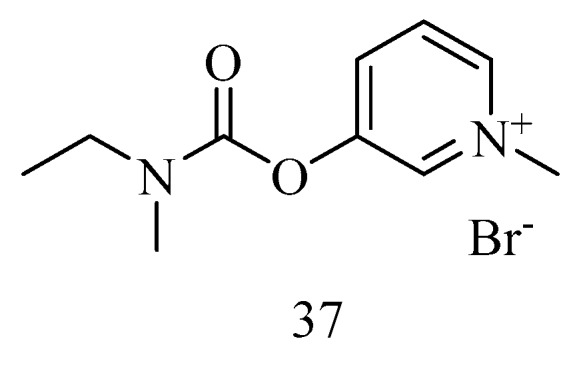
Pyridostigmine bromide.
6. Irreversible Inhibition of AChE: The Chemistry of Nerve Agents
As expected, the irreversible AChE inhibition may result in life-threatening effects, according to the level of exposure and resources available to treat affected victims. The overstimulation may trigger a series of symptoms represented by the acronym SLUDGEM (Salivation, Lachrimation, Urination, Defecation, Gastrintestinal disturbs, Emesis, Myosis, and Muscle spasms) which illustrates the clinical effects. Acute exposure may be fatal due to the respiratory failure resulting from the continuous stimulation of neuromuscular junctions at diaphragm, as described earlier in this paper [6,14,19,20,53,54,150]. Classic (G- and V-Series) and “Novichok” nerve agents (Figure 1, Figure 2, Figure 3 and Figure 4) listed in the CWC in its Schedule 1, Part A, are example compounds. Structurally related to nerve agents, some pesticides, such as chlorpyrifos 22 and aldicarb 23 (Figure 6), paraoxon 38 (Figure 12) (used in many studies for development of antidotes towards cholinesterase inhibitors), and malathion 39 (Figure 12), a compound still used as aerosol to combat arboviruses vectors in developing countries (Figure 12) [3,4,5,6,8,19,45,46,50,53,54,151,152,153,154].
Figure 12.
Organophosphorus pesticides paraoxon and malathion.
The toxicity related to organophosphorus compounds may be explained through the high affinity of phosphorus and oxygen, with higher energy bonds, 335 and 544 kJ/mol, for P-O and P=O bonds, respectively [155]. Poisoning and environmental contamination by organophosphorus pesticides poses a serious public health challenge in countries with lack of control of these substances. Nonetheless, occupational poisoning is not the sole problem. Cases of pesticide use in suicides are also known. The World Health Organization (WHO) estimated more than 200,000 casualties per year by poisoning with organophosphorus pesticides in developing countries. Recently in India, more than 20 children died after eating a meal prepared with oil stored in monocrotophos-contaminated bottles (40, Figure 13) [156,157]. As an alternative, many countries have adopted neonicotinoids as insecticides, which are less toxic to mammalians and birds. However, they are under scrutiny due to toxicity for pollinator insects [158,159].
Figure 13.
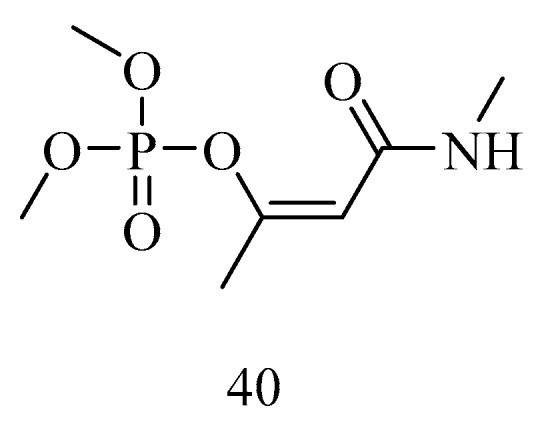
Monocrotophos.
Depending on the AChE adduct formed with organophosphorus compounds (31, Scheme 3A), the displacement of the O-alkyl moiety can lead to enzymatic aging. The generated phosphonate anion 41 is stabilized by the protonated histidine imidazole moiety located at the catalytic ES, affecting the antidote efficacy. Adduct of GD with AChE 42 quickly undergoes such process (Scheme 4) [160,161,162,163,164,165,166,167].
Scheme 4.
Aging of AChE-GD adduct.
The knowledge on the reaction between nerve agents and cholinesterases may be useful to identify exposure to such toxic chemicals. In blood and plasma samples, nerve agents may be found in their hydrolyzed forms, mainly alkylphosphonic acids, but also as adducts with BChE 44. If this adduct is aged 45, its digestion yields a phosphylated nonapeptitde 46 (FGESAGAAS, A: Alanine, E: Glutamate, F: Phenylalanine, G: Glycine, S: Serine) that can be used as proof of exposure to nerve agents. Nevertheless, if the enzyme is not aged 44, treatment with fluoride ions enables a de novo synthesis of the organophosphorus compound 47. These compounds can be successfully detected by chromatographic and spectrometric techniques (Scheme 5). This reaction between BChE and neurotoxic CWC Schedule 1A not only highlights the importance of this enzyme as a biomarker, but also illustrates its potential use as a bioscavenger. Therefore, it can be a potential prophylactic measure by reacting in stoichiometric manner with nerve agents [168,169,170,171,172,173,174,175,176,177,178,179,180,181].
Scheme 5.
Digestion and fluoride reactivation products from biological matrices.
7. Rescuing Cholinesterases: Antidotes towards Nerve Agents
In order to rescue organophosphorus-inhibited AChE and BChE, appropriate antidote therapy must be promptly employed. Rapid response is required to lessen the risk of neurological damage and even death. Antidotes usually are a mixture of three different compounds, an enzyme reactivator (to remove the organophosphorus from catalytic ES), an anticholinergic agent (to counteract the effects of the higher concentration of the neurotransmitter), and an anticonvulsant (to control seizures). Up to date, pyridinium oximes have been clinically used as AChE reactivators, pralidoxime 48, obidoxime 49, trimedoxime 50, HI-6 51, HLö-7 52 and K027 53 are representative compounds (Figure 14) [4,182,183,184,185,186]. At the physiological pH oximes afford oximates. These nucleophiles reactivate cholinesterases through a nucleophilic attack on the phosphorus atom, releasing the hydroxyl serine residue. Scheme 6 depicts the reaction of a pyridinium oximate 54 and an organophosphorus-inhibited cholinesterase 56 [4,99,160,161,185,186,187,188,189,190,191,192,193].
Figure 14.
Oximes clinically used as antidotes for organophosphorus poisoning. X = chloride, mesylate or iodine for 48, chloride for 49, bromide for 50 and 53, chloride or mesylate for 51 and 52.
Scheme 6.
Reactivation of AChE through pyridinium oximes.
Marketed kits also contain atropine 59 as anticholinergic agent, and an anticonvulsant, such as diazepam 60 (Figure 15). Seizures may be related to the excitotoxicity that takes place due to unbalanced levels of glutamate and γ-aminobutyric acid (GABA) in brain in the course of AChE inhibition. The use of glutamate antagonists and GABA agonists may be a valuable therapeutic approach [4,194,195,196,197].
Figure 15.
Atropine and diazepam.
Due to the cationic profile of all available antidotes, permeation into the blood-brain barrier (BBB) hinders effective treatment. Additionally, an efficient “universal antidote’ towards all cholinesterase inhibitors is not yet available [198]. To tackle these limitations, development of more lipophilic compounds and novel routes of administration of antidotes have been extensively studied [4,199,200,201,202,203,204,205].
8. Final Remarks
Cholinesterases are constitutive enzymes, essential to the correct performance of the parasympathetic nervous system (PNS). The chemistry of AChE inhibition and aging in the context of the contemporary issue of terrorism by chemical warfare is an attractive conduit for chemical education and for dual use, military and civilian research work. AChE has a pivotal role in memory and learning, therefore increased knowledge on AChE function may facilitate the development of further, more effective therapies towards neurodegenerative diseases, like AD. Besides the varied conceptual background in Chemistry that it demands, the subject is also multidisciplinary, since it is related to pharmacology, toxicology, medicinal chemistry, international politics, health, environmental and forensics sciences, as well ethical issues.
Acknowledgments
Authors would like to thank Brazilian Army and Walter Mors Institute of Research on Natural Products—Federal University of Rio de Janeiro, Brazil, for infrastructure, Brazilian National Authority and Brazilian Ministry of Defense for support, University of Hradec Králové for technical and financial cooperation. S.F.d.A.C. also acknowledges OPCW and Organic Synthesis Group at Spiez Laboratory—Switzerland for the Organic Synthesis Fellowship in 2012. The Authors also acknowledges Bentham Science Publishers for granting the use of the Figure 9, published originally in the Ref. 4, and Angelo A. T. Silva (Federal Institute of Rio de Janeiro at Nilópolis, Rio de Janeiro, Brazil) for discussions on Graphical Abstract.
Author Contributions
Conceptualization, S.F.d.A.C., A.B.C.S., K.K. and T.C.C.F.; writing—original draft preparation, S.F.d.A.C., A.B.C.S., and T.C.C.F.; writing—review and editing, S.F.d.A.C., A.B.C.S., M.C.B., R.B.S., V.G.M.d.O., P.A.d.M.C., K.K. and T.C.C.F.; project administration, S.F.d.A.C., A.B.C.S., K.K., T.C.C.F.; funding acquisition, S.F.d.A.C., A.B.C.S., M.C.B., V.G.M.d.O., P.A.d.M.C., K.K. and T.C.C.F. All authors have read and agreed to the published version of the manuscript.
Funding
This research project was funded by Organisation for the Prohibition of Chemical Weapons—OPCW, grant number L/ICA/ICB/201062/15 (2016-2018) and Brazilian Army. It was also supported by This work was also supported by the Czech Science Foundation (no. 18-01734S) and University of Hradec Kralove (Faculty of Science, no. VT2019-2021).
Conflicts of Interest
The funders had no role in the design of the study; in the collection, analyses, or interpretation of data; in the writing of the manuscript, or in the decision to publish the results.
Disclaimer
Due to information presented in this manuscript, the Authors and Publisher should not be responsible or held accountable for misuse or incorrect handling of toxic organophosphorus compounds. Readers must access the website of the Organization for the Prohibition of Chemical Weapons (OPCW, www.opcw.org) and read carefully Chemical Weapons Convention to obtain further sources of information about legal framework when working with the organophosphorus chemistry.
References
- 1.OPCW. [(accessed on 3 January 2020)]; Available online: www.opcw.org.
- 2.Organisation for the Prohibition of Chemical Weapons—OPCW. [(accessed on 3 January 2020)]; Available online: https://www.opcw.org/about-us/history.
- 3.Chemical Weapons Convention—CWC. [(accessed on 3 January 2020)]; Available online: https://www.opcw.org/chemical-weapons-convention.
- 4.Cavalcante S.F.A., Simas A.B.C., Kuča K. Nerve Agents’ Surrogates: Invaluable Tools for Development of Acetylcholinesterase Reactivators. Curr. Org. Chem. 2019;23:1539–1559. doi: 10.2174/1385272823666190806114017. [DOI] [Google Scholar]
- 5.Darling R.G., Noste R.E. In: Ciottone’s Disaster Medicine. Ciottone G.R., editor. Elsevier Science; Amsterdam, The Netherlands: 2016. pp. 489–498. [Google Scholar]
- 6.Nepovimova E., Kuča K. The history of poisoning: From ancient times until modern era. Arch. Toxicol. 2019;93:11–24. doi: 10.1007/s00204-018-2290-0. [DOI] [PubMed] [Google Scholar]
- 7.Vale A., Marrs T.C., Rice P. Chemical terrorism and nerve agents. Medicine. 2016;44:106–108. doi: 10.1016/j.mpmed.2015.11.004. [DOI] [Google Scholar]
- 8.Delfino R.T., Ribeiro T.S., Figueroa-Villar J.D. Organophosphorus Compounds as Chemical Warfare Agents: A Review. J. Braz. Chem. Soc. 2009;20:407–428. doi: 10.1590/S0103-50532009000300003. [DOI] [Google Scholar]
- 9.Greenfield R.A., Brown B.R., Hutchins J.B., Iandolo J.J., Jackson R., Slater L.N., Bronze M.S. Microbiological, biological, and chemical weapons of warfare and terrorism. Am. J. Med. Sci. 2002;323:326–340. doi: 10.1097/00000441-200206000-00005. [DOI] [PubMed] [Google Scholar]
- 10.Epstein J. Weapons of Mass Destruction: Is is all about Chemistry. J. Chem. Ed. 2009;86:1377–1381. doi: 10.1021/ed086p1377. [DOI] [Google Scholar]
- 11.Constanzi S., Machado J.H., Mitchell M. Nerve Agents: What They Are, How They Work, How to Counter Them. ACS Chem. Neurosci. 2018;9:873–885. doi: 10.1021/acschemneuro.8b00148. [DOI] [PubMed] [Google Scholar]
- 12.Tammelin L.E. Dialkoxy-phosphorylthiocholines, alkoxy-methyl-phosphorylthiocholines and analogous choline esters. Syntheses, pKa of tertiary homologues and cholinesterase inhibition. Acta Chem. Scand. 1957;11:1340–1349. doi: 10.3891/acta.chem.scand.11-1340. [DOI] [Google Scholar]
- 13.Tammelin L.E. Methyl-fluoro-phosphorylcholines. Two synthetic cholinergic drugs and their tertiary homologues. Acta Chem. Scand. 1957;11:859–865. doi: 10.3891/acta.chem.scand.11-0859. [DOI] [Google Scholar]
- 14.Makhaeva G.F., Filonenko I.V., Yankovskaya V.L., Fomicheva S.B., Malygin V.V. Comparative studies of O,O-dialkyl-O-chloromethylchloroformimino phosphates: Interaction with neuropathy target esterase and acetylcholinesterase. Neurotoxicology. 1998;19:623–628. [PubMed] [Google Scholar]
- 15.Rozengart E.V., Basova N.E., Moralev S.N., Lushchekina S.V., Masson P., Varfolomeev S.D. Research on cholinesterases in the Soviet Union and Russia: A historical perspective. Chem. Biol. Interact. 2013;203:3–9. doi: 10.1016/j.cbi.2013.02.002. [DOI] [PubMed] [Google Scholar]
- 16.Macilawain C. Study proves Iraq used nerve gas. Nature. 1993;363:3. doi: 10.1038/363003b0. [DOI] [PubMed] [Google Scholar]
- 17.BBC. [(accessed on 3 January 2020)]; Available online: http://news.bbc.co.uk/onthisday/hi/dates/stories/march/16/newsid_4304000/4304853.stm.
- 18.United Nations. [(accessed on 3 January 2020)]; Available online: http://www.sciencediplomacy.org/perspective/2015/intersection-science-and-chemical-disarmament.
- 19.Yanagisawa N. The nerve agent sarin: History, clinical manifestations, and treatment. Brain Nerve. 2014;66:561–569. [PubMed] [Google Scholar]
- 20.Yanagisawa N., Morita H., Nakajima T. Sarin Experiences in Japan: Acute Toxicity and Long-term Effects. J. Neurol. Sci. 2006;249:76–85. doi: 10.1016/j.jns.2006.06.007. [DOI] [PubMed] [Google Scholar]
- 21.Nagao M., Takatori T., Matsuda Y., Nakajima M., Iwase H., Iwadate K. Definitive for Evidence for the Acute Sarin Poisoning Diagnosis in Tokyo Subway. Toxicol. Appl. Pharm. 1997;144:198–203. doi: 10.1006/taap.1997.8110. [DOI] [PubMed] [Google Scholar]
- 22.Greaves I., Hunt P. Responding to Terrorism: A Medical Handbook. Churchill Livingstone; London, UK: 2011. [Google Scholar]
- 23.Evison D., Hinsley D., Rice P. Chemical Weapons. BMJ. 2002;324:332–335. doi: 10.1136/bmj.324.7333.332. [DOI] [PMC free article] [PubMed] [Google Scholar]
- 24.Riddle J.R., Brown M., Smith T., Ritchie E.C., Brix K.A., Romano J. Chemical warfare and the Gulf War: A review of the impact on Gulf Veteran’s health. Mil. Med. 2003;168:606–613. doi: 10.1093/milmed/168.8.606. [DOI] [PubMed] [Google Scholar]
- 25.Gooch E.E. Chemistry and Warfare: A general studies course. J. Chem. Ed. 2002;79:820–821. doi: 10.1021/ed079p820. [DOI] [Google Scholar]
- 26.Jang Y.J., Kim K., Tsay O.G., Atwood D.A., Churchill D.G. Destruction and Detection of Chemical Warfare Agents. Chem. Rev. 2015;115:PR1–PR76. doi: 10.1021/acs.chemrev.5b00402. [DOI] [PubMed] [Google Scholar]
- 27.Organisation for the Prohibition of Chemical Weapons—OPCW. [(accessed on 3 March 2020)]; Available online: https://www.opcw.org/sites/default/files/documents/EC/87/en/ec87nat14_e_.pdf.
- 28.Arms Control Association ChemicalWeapons: Frequently Asked Questions. [(accessed on 6 March 2020)]; Available online: https://www.armscontrol.org/factsheets/Chemical-Weapons-Frequently-Asked-Questions.
- 29.Nozaki H., Aikawa N., Fujishima S., Suzuki M., Shinozawa Y., Hori S., Nogawa W. A case of VX poisoning and the difference from sarin. Lancet. 1995;346:698–699. doi: 10.1016/S0140-6736(95)92306-3. [DOI] [PubMed] [Google Scholar]
- 30.Raveh L., Eisenkraft A., Weissman B.A. Caramiphen edisylate: An optimal antidote against organophosphate poisoning. Toxicology. 2014;325:115–124. doi: 10.1016/j.tox.2014.09.005. [DOI] [PubMed] [Google Scholar]
- 31.Dolgin E. Syrian gas attack reinforces need for better anti-sarin drugs. Nat. Med. 2013;19:1194–1195. doi: 10.1038/nm1013-1194. [DOI] [PubMed] [Google Scholar]
- 32.Kaiser J. As Syria Crisis Mounts, Scientist Looks Back at Last Major Chemical Attack. Science. 2013;341:1051. doi: 10.1126/science.341.6150.1051. [DOI] [PubMed] [Google Scholar]
- 33.Patrick K., Stanbrook M., Flegel K. Lest We Forget: Why the Use of Chemical Weapons Must not Go Unchallenged. Can. Med. Assoc. J. 2013;185:1299. doi: 10.1503/cmaj.131359. [DOI] [PMC free article] [PubMed] [Google Scholar]
- 34.Science Mag. [(accessed on 3 January 2020)]; Available online: https://www.sciencemag.org/news/2013/08/syria-crisis-mounts-scientist-looks-back-25-years-after-investigating-halabja-gas.
- 35.Enserink M.U.N. Taps Special Labs to Investigate Syrian Attack. Science. 2013;341:1050–1051. doi: 10.1126/science.341.6150.1050. [DOI] [PubMed] [Google Scholar]
- 36.Vogel L. WHO releases guidelines for treating chemical warfare victims after possible Syria attacks. Can. Med. Assoc. J. 2013;185:E665. doi: 10.1503/cmaj.109-4592. [DOI] [PMC free article] [PubMed] [Google Scholar]
- 37.Gulland A. Lack of atropine in Syria hampers treatment after gas attacks. BMJ. 2013;347:f5413. doi: 10.1136/bmj.f5413. [DOI] [PubMed] [Google Scholar]
- 38.Asai Y., Arnold J.L. Terrorism in Japan. Prehospital Disaster Med. 2003;18:106. doi: 10.1017/S1049023X00000844. [DOI] [PubMed] [Google Scholar]
- 39.OPCW. [(accessed on 3 January 2020)]; Available online: https://www.opcw.org/news/article/statement-from-opcw-spokesperson-in-response-to-media-queries-regarding-alleged-use-of-nerve-agent-vx-in-malaysia/
- 40.Sputnik News. [(accessed on 3 January 2020)]; Available online: https://sputniknews.com/asia/201703031051219306-opcw-kim-jong-nam-probe/
- 41.Channels New Asia. [(accessed on 3 January 2020)]; Available online: http://www.channelnewsasia.com/news/asiapacific/malaysia-to-fully-cooperate-with-opcw-on-vx-probe-ministry/3564532.html.
- 42.Yle Uutiset. [(accessed on 3 January 2020)]; Available online: http://yle.fi/uutiset/3-9503798.
- 43.BBC. [(accessed on 3 January 2020)]; Available online: http://www.bbc.com/news/world-europe-43835774.
- 44.Organisation for the Prohibition of Chemical Weapons—OPCW SAB Director-General’s Request to the Scientific Advisory Board to Provide Advice on New Types of Nerve Agents. [(accessed on 3 March 2020)];2018 May 2; Available online: https://www.opcw.org/sites/default/files/documents/S_series/2018/en/s-1621-2018_e_pdf.
- 45.Nepovimova E., Kuča K. Chemical warfare agent NOVICHOK—Mini-review of available data. Food Chem. Toxicol. 2018;121:343–350. doi: 10.1016/j.fct.2018.09.015. [DOI] [PubMed] [Google Scholar]
- 46.França T.C.C., Kitagawa D.A.S., Cavalcante S.F.A., da Silva J.A.V., Nepovimova E., Kuča K. Novichoks: The Dangerous Forth Generation of Chemical Weapons. Int. J. Mol. Sci. 2019;20:1222. doi: 10.3390/ijms20051222. [DOI] [PMC free article] [PubMed] [Google Scholar]
- 47.US Department of Commerce—Bureau of Industry and Security Impact of Proposed Additions to the ‘‘Annex on Chemicals’’ to the Chemical Weapons Convention (CWC) on Legitimate Commercial Chemical, Biotechnology, and Pharmaceutical Activities Involving ‘‘Schedule 1′’ Chemicals (Including Schedule 1 Chemicals Produced as Intermediates) [(accessed on 3 January 2020)]; Available online: https://www.cwc.gov/84%20FR%2040389%20I%20NOI%20on%20Schedule%201%20Novichoks%20-%20Impact%20proposed%20CWC%20additions%208-14-19.pdf.
- 48.Organisation for the Prohibition of Chemical Weapons—OPCW Note by the Technical Secretariat: Consolidated Text of Adopted Changes to Schedule 1 of the Annex on Chemicals to the Chemical Weapons Convention. [(accessed on 3 January 2020)]; Available online: https://www.opcw.org/sites/default/files/documents/2019/12/s-1820-2019%28e%29.pdf.
- 49.Sommer H.Z., Wicks G.E., Jr. Chemical Agents. 4241212. U.S. Patent. 1980 Dec 23;
- 50.Ellison H.D. Handbook of Chemical and Biological Warfare Agents. CRC Press; Boca Raton, FL, USA: 2008. [Google Scholar]
- 51.Tucker J. War of Nerves: Chemical Warfare from World War I to Al-Qaeda. Anchor; New York, NY, USA: 2007. [Google Scholar]
- 52.Schwenk M. Chemical warfare agents. Classes and targets. Toxicol. Lett. 2017;293:253–263. doi: 10.1016/j.toxlet.2017.11.040. [DOI] [PubMed] [Google Scholar]
- 53.Soltaninejad K., Shadnia S. In: Basic and Clinical Toxicology of Organophosphorus Compounds. Balali-Mood M., Abdollahi M., editors. Springer; London, UK: 2014. [Google Scholar]
- 54.Moyer R.A., Sidell F.R., Salem H. In: Encyclopedia of Toxicology. Wexler P., editor. Elsevier Science; Amsterdam, The Netherlands: 2014. pp. 483–488. [Google Scholar]
- 55.Talabani J.M., Ali A.I., Kadir A.M., Rashid R., Samin F., Greenwood D., Hay A.W.M. Long-term health effects of chemical warfare agents on children following a single heavy exposure. Hum. Exp. Toxicol. 2018;37:836–847. doi: 10.1177/0960327117734620. [DOI] [PubMed] [Google Scholar]
- 56.Worek F., Wille T., Koller M., Thiermann H. Toxicology of organophosphorus compounds in view of an increasing terrorist threat. Arch. Toxicol. 2016;90:2131–2145. doi: 10.1007/s00204-016-1772-1. [DOI] [PubMed] [Google Scholar]
- 57.Chowdhary S., Bhattacharyya R., Banerjee D. Acute organophosphorus poisoning. Clin. Chim. Acta. 2014;431:66–76. doi: 10.1016/j.cca.2014.01.024. [DOI] [PubMed] [Google Scholar]
- 58.Quinn D.M. Acetylcholinesterase: Enzyme Structure, Reaction Dynamics, and Virtual Transition States. Chem. Rev. 1987;87:955–979. doi: 10.1021/cr00081a005. [DOI] [Google Scholar]
- 59.Chatonnet A., Lockridge O. Comparison of Butyrylcholinestarse and Acetylcholinesterase. Biochem. J. 1989;260:625–634. doi: 10.1042/bj2600625. [DOI] [PMC free article] [PubMed] [Google Scholar]
- 60.Saxena A., Redman A.M.G., Jiang X., Lockridge O., Doctor B.P. Differences in Active Site Gorge Dimensions of Cholinesterases Revealed by Binding of Inhibitors to Human Butyrylcholinesterase. Chem. Biol. Interact. 1999;119–120:61–69. doi: 10.1016/S0009-2797(99)00014-9. [DOI] [PubMed] [Google Scholar]
- 61.Taylor P. The Cholinesterases. J. Biol. Chem. 1991;266:4025–4028. [PubMed] [Google Scholar]
- 62.Taylor P., Radić Z. The Cholinesterases: From Genes to Proteins. Annu. Rev. Pharmacol. Toxicol. 1994;34:281–320. doi: 10.1146/annurev.pa.34.040194.001433. [DOI] [PubMed] [Google Scholar]
- 63.Sussman J.L., Silman I. Acetylcholinesterase: Structure and use as a model for specific cation-protein interactions. Curr. Opin. Struct. Biol. 1992;2:721–729. doi: 10.1016/0959-440X(92)90207-N. [DOI] [Google Scholar]
- 64.Soreq H., Seidman S. Acetylcholinesterase—New Roles for an Old Actor. Nat. Rev. 2001;2:294–302. doi: 10.1038/35067589. [DOI] [PubMed] [Google Scholar]
- 65.Silman I., Sussman J.L. Acetylcholinesterase: “Classical” and “Non-classical” Functions and Pharmacology. Curr. Opin. Pharmacol. 2005;5:293–302. doi: 10.1016/j.coph.2005.01.014. [DOI] [PubMed] [Google Scholar]
- 66.Dvir H., Silman I., Harel M., Rosenberry T.L., Sussman J.L. Acetylcholinesterase: From 3D structure to function. Chem. Biol. Interact. 2010;187:10–22. doi: 10.1016/j.cbi.2010.01.042. [DOI] [PMC free article] [PubMed] [Google Scholar]
- 67.Lockridge O. Review of human butyrylcholinesterase structure, function, genetic variants, history of use in the clinic, and potential therapeutic uses. Pharmacol. Ther. 2015;148:34–46. doi: 10.1016/j.pharmthera.2014.11.011. [DOI] [PubMed] [Google Scholar]
- 68.Nobel Prize Foundation. [(accessed on 3 March 2020)]; Available online: http://www.nobelprize.org/nobel_prizes/peace/laureates/2013/opcw-facts.html.
- 69.Black R.M., Harrison J.M. In: The Chemistry of Organophosphorus Compounds, Vol 4, Ter- and Quinquephosphorus Acids and Their Derivatives. Hartley F.R., editor. John Wiley & Sons; Chichester, UK: 1996. pp. 781–840. [Google Scholar]
- 70.Mundy J.L., Harrison J.M., Watts P., Timperley C.M. Isotopically labelled phosphorus compounds: Some deuterated methyl and ethyl derivatives. Phosphorus Sulfur Silicon Relat. Elem. 2006;181:1847–1857. doi: 10.1080/10426500500543008. [DOI] [Google Scholar]
- 71.Timperley C.M. Best Synthetic Methods. 1st ed. Chemistry Academic Press; Massachusetts, MA, USA: 2014. Organophosphorus (V) [Google Scholar]
- 72.Ledgard J. The Preparatory Manual of Chemical Warfare Agents. 3rd ed. UVKCHEM; Puyallup, UK: 2006. [Google Scholar]
- 73.Tajti Á., Keglevich G. The importance of organophosphorus compounds as biologically active agents. In: Keglevich G., editor. Organophosphorus Chemistry—Novel Developments. De Gruyter; Berlin, Germany: Boston, MA, USA: 2018. pp. 53–65. Chapter 3. [Google Scholar]
- 74.Mattes C.E., Lynch T.J., Singh A., Bradley R.M., Kellaris P.A., Brady R.O., Dretchen K.L. Therapeutic use of butyrylcholinesterase for cocaine intoxication. Toxicol. Appl. Pharmacol. 1997;145:372–380. doi: 10.1006/taap.1997.8188. [DOI] [PubMed] [Google Scholar]
- 75.Carmona G.N., Jufer R.A., Goldberg S.R., Gorelick D.A., Greig N.H., Yu Q.S., Cone E.J., Schindler C.W. Butyrylcholinesterase accelerates cocaine metabolism: In vitro and in vivo effects in nonhuman primates and humans. Drug Metab. Dispos. 2000;28:367–371. [PubMed] [Google Scholar]
- 76.Brimijoin S., Gao Y., Geng L., Chen V.P. Treating Cocaine Addiction, Obesity, and Emotional Disorders by Viral Gene Transfer of Butyrylcholinesterase. Front. Pharmacol. 2018;9:1–6. doi: 10.3389/fphar.2018.00112. [DOI] [PMC free article] [PubMed] [Google Scholar]
- 77.Murthy V., Brimijoin S. Cocaine and Butyrylcholinesterase Gene Therapy. In: Preedy V.R., editor. The Neuroscience of Cocaine—Mechanisms and Treatment. Academic Press; Cambridge, MA, USA: 2017. pp. 673–678. Chapter 68. [Google Scholar]
- 78.Masson P., Lockridge O. Butyrylcholinesterase for protection from organophosphorus poisons: Catalytic complexities and hysteretic behavior. Arch. Biochem. Biophys. 2010;494:107–120. doi: 10.1016/j.abb.2009.12.005. [DOI] [PMC free article] [PubMed] [Google Scholar]
- 79.Zhang P., Jain P., Tsao C., Sinclair A., Sun F., Hung H.-C., Bai T., Wu K., Jiang S. Butyrylcholinesterase nanocapsule as a long circulating bioscavenger with reduced immune response. J. Control. Release. 2016;230:73–78. doi: 10.1016/j.jconrel.2016.04.008. [DOI] [PubMed] [Google Scholar]
- 80.Rice H., Mann T.M., Armstrong S.J., Price M.E., Green A.C., Tattersall J.E.H. The potential role of bioscavenger in the medical management of nerve-agent poisoned casualties. Chem. Biol. Interact. 2016;259:175–181. doi: 10.1016/j.cbi.2016.04.038. [DOI] [PubMed] [Google Scholar]
- 81.Lushchekina S.V., Schopfer L.M., Grigorenko B.L., Nemukhin A.V., Varfolomeev S.D., Lockridge O., Masson P. Optimization of Cholinesterase-Based Catalytic Bioscavengers Against Organophosphorus Agents. Front. Pharmacol. 2018;9:1–13. doi: 10.3389/fphar.2018.00211. [DOI] [PMC free article] [PubMed] [Google Scholar]
- 82.Nachon F., Brazzolotto X., Trovaslet M., Masson P. Progress in the development of enzyme-based nerve agent bioscavengers. Chem. Biol. Interact. 2013;206:536–544. doi: 10.1016/j.cbi.2013.06.012. [DOI] [PubMed] [Google Scholar]
- 83.Cerasoli D.M., Griffiths E.M., Doctor B.P., Saxena A., Fedorko J.M., Greig N.H., Yu Q.S., Huang Y., Wilgus H., Karatzas C.N., et al. In vitro and in vivo characterization of recombinant human butyrylcholinesterase (Protexia) as a potential nerve agent bioscavenger. Chem. Biol. Interact. 2005;157–158:363–365. doi: 10.1016/j.cbi.2005.10.052. [DOI] [PubMed] [Google Scholar]
- 84.Musilek K., Holas O., Horova A., Pohanka M., Zdarova-Karasova J., Jun D., Kuca K. In: Pesticides in the Modern World—Effects of Pesticides Exposure. Stoytcheva M., editor. InTech; London, UK: 2011. [(accessed on 3 March 2020)]. Available online: http://www.intechopen.com/books/pesticides-in-the-modern-worldeffects-of-pesticides-exposure/progress-in-antidotes-acetylcholinesterase-reactivators-againstorganophosphorus-pesticides. [Google Scholar]
- 85.Thomas E.A., Bornstein J.C. Inhibitory cotransmission or after-hyperpolarizing potentials can regulate firing in recurrent networks with excitatory metabotropic transmission. Neuroscience. 2003;120:333–351. doi: 10.1016/S0306-4522(03)00039-3. [DOI] [PubMed] [Google Scholar]
- 86.Shafferman A., Kronman C., Flashner Y., Leitner M., Grosfeld H., Ordentlich A., Gozes Y., Cohen S., Ariel N., Barak D., et al. Mutagenesis of Human Acetylcholinesterase. J. Biol. Chem. 1992;25:17640–17648. [PubMed] [Google Scholar]
- 87.Lockridge O. Structure of human serum cholinesterase. Bioessays. 1988;9:125–128. doi: 10.1002/bies.950090406. [DOI] [PubMed] [Google Scholar]
- 88.Vellom D.C., Radic Z., Li Y., Pickering N.A., Camp S., Taylor P. Amino acid residues controlling acetylcholinesterase and butyrylcholinesterase specificity. Biochemistry. 1993;32:12–17. doi: 10.1021/bi00052a003. [DOI] [PubMed] [Google Scholar]
- 89.Hörnberg A., Tunemalm A.K., Ekström F. Crystal structures of acetylcholinesterase in complex with organophosphorus compounds suggest that the acyl pocket modulates the aging reaction by precluding the formation of the trigonal bipyramidal transition state. Biochemistry. 2007;46:4815–4825. doi: 10.1021/bi0621361. [DOI] [PubMed] [Google Scholar]
- 90.Bartling A., Worek F., Szinicz L., Thiermann H. Enzyme-kinetic investigation of different sarin analogues reacting with human acetylcholinesterase and butyrylcholinesterase. Toxicology. 2007;233:166–172. doi: 10.1016/j.tox.2006.07.003. [DOI] [PubMed] [Google Scholar]
- 91.Nicolet Y., Lockridge O., Masson P., Fontecilla-Camps J.C., Nachon F. Crystal Structure of Human Butyrylcholinesterase and of Its Complexes with Substrate and Products. Biol. Chem. 2003;278:41141–41147. doi: 10.1074/jbc.M210241200. [DOI] [PubMed] [Google Scholar]
- 92.Bencsura A., Enyedy I.Y., Kovach I.M. Probing the Active Site of Acetylcholinesterase by Molecular Dynamics of Its Phosphonate Ester Adducts. J. Am. Chem. Soc. 1996;118:8531–8541. doi: 10.1021/ja952406v. [DOI] [Google Scholar]
- 93.Ballard C., Gauthier S., Corbett A., Brayne C., Aarsland D., Jones E. Alzheimer’s disease. Lancet. 2011;377:1019–1031. doi: 10.1016/S0140-6736(10)61349-9. [DOI] [PubMed] [Google Scholar]
- 94.Okumura T., Seto Y., Fuse A. Countermeasures against chemical terrorism in Japan. Forensic Sci. Int. 2013;227:2–6. doi: 10.1016/j.forsciint.2012.11.008. [DOI] [PubMed] [Google Scholar]
- 95.Tu A.T. Aum Shinrikyo’s chemical and biological weapons: More than sarin. Forensic Sci. Rev. 2014;26:115–120. [PubMed] [Google Scholar]
- 96.Hardacre H. Aum Shinrikyo and the Japanese Media. [(accessed on 3 March 2020)];1996 JPRI Working Paper No. 19. Available online: http://www.jpri.org/publications/workingpapers/wp19.html.
- 97.Hroudová J., Singh N., Fišar Z., Ghosh K.K. Progress in drug development for Alzheimer’s disease: An overview in relation to mitochondrial energy metabolism. Eur. J. Med. Chem. 2016;121:774–784. doi: 10.1016/j.ejmech.2016.03.084. [DOI] [PubMed] [Google Scholar]
- 98.Seto Y. The Sarin Gas Attack in Japan and the Related Forensic Investigation. [(accessed on 20 January 2020)];OPCW Synth. 2001 June:14–17. Available online: https://www.opcw.org/news/article/the-sarin-gas-attack-in-japan-and-the-related-forensic-investigation. [Google Scholar]
- 99.Gorecki L., Korabecny J., Musilek K., Malinak D., Nepovimova E., Dolezal R., Jun D., Soukup O., Kuča K. SAR study to find optimal cholinesterase reactivator against organophosphorous nerve agents and pesticides. Arch. Toxicol. 2016;90:2831–2859. doi: 10.1007/s00204-016-1827-3. [DOI] [PubMed] [Google Scholar]
- 100.Pohanka M. Cholinesterases, a target of Pharmacology and Toxicology. Biomed. Pap. Med. Fac. Univ. Palacky Olomouc Czech Repub. 2011;155:219–230. doi: 10.5507/bp.2011.036. [DOI] [PubMed] [Google Scholar]
- 101.Pohanka M. Acetylcholinesterase inhibitors: A patent review (2008–present) Expert Opin. Ther. Pat. 2012:1–16. doi: 10.1517/13543776.2012.701620. [DOI] [PubMed] [Google Scholar]
- 102.Franjesevic A.J., Sillart S.B., Beck J.M., Vyas S., Callam C.S., Hadad C.M. Ressurrectionand reactivation of acetylcholinesterase and butyrylcholinesterase. Chem. Eur. J. 2019;25:5337–5371. doi: 10.1002/chem.201805075. [DOI] [PMC free article] [PubMed] [Google Scholar]
- 103.Tõugu V. Acetylcholinesterase: Mechanism of Catalysis and Inhibition. Curr. Med. Chem. 2001;1:155–170. doi: 10.2174/1568015013358536. [DOI] [Google Scholar]
- 104.Greenfield S., Vaux D.J. Parkinson’s disease, Alzheimer’s disease and motor neurone disease: Identifying a common mechanism. Neuroscience. 2002;113:485–492. doi: 10.1016/S0306-4522(02)00194-X. [DOI] [PubMed] [Google Scholar]
- 105.Brinton R.D., Yamazaki R.S. Advances and Challenges in the Prevention and Treatment of Alzheimer’s Disease. Pharm. Res. 1998;15:386–398. doi: 10.1023/A:1011963929012. [DOI] [PubMed] [Google Scholar]
- 106.Butterfield D.A., Lauderback C.M. Lipid peroxidation and protein oxidation in Alzheimer’s disease brain: Potential causes and consequences involving amyloid beta-peptide-associated free radical oxidative stress. Free Radic. Biol. Med. 2002;32:1050–1060. doi: 10.1016/S0891-5849(02)00794-3. [DOI] [PubMed] [Google Scholar]
- 107.Blennow K., de Leon M.J., Zetterberg K. Alzheimer’s disease. Lancet. 2006;368:387–403. doi: 10.1016/S0140-6736(06)69113-7. [DOI] [PubMed] [Google Scholar]
- 108.Scarpinia E., Schelternsa P., Feldman H. Treatment of Alzheimer’s disease; current status and new perspectives. Lancet Neurol. 2003;2:539–547. doi: 10.1016/S1474-4422(03)00502-7. [DOI] [PubMed] [Google Scholar]
- 109.Rösler M., Anand R., Cicin-Sain A., Gauthier S., Agid Y., Dal-Bianco P., Stähelin H.B., Hartman R., Gharabawi M. Efficacy and safety of rivastigmine in patients with Alzheimer’s disease: International randomised controlled trial. BMJ. 1999;318:633–638. doi: 10.1136/bmj.318.7184.633. [DOI] [PMC free article] [PubMed] [Google Scholar]
- 110.Fifer E.K. Drugs affecting cholinergic neurotransmission. In: Lemke T.L., Williams D.A., editors. Foye’s Medicinal Chemistry. 6th ed. Lippincott Williams & Wilkins, Baltimore; Philadelphia, PA, USA: 2008. pp. 361–391. Chapter 12. [Google Scholar]
- 111.Pohanka M. Inhibitors of acetylcholinesterase and butyrylcholinesterase meet immunity. Int. J. Mol. Sci. 2014;15:9809–9825. doi: 10.3390/ijms15069809. [DOI] [PMC free article] [PubMed] [Google Scholar]
- 112.Glenner G.G., Wong C.W. Alzheimer’s Disease: Initial Report Of The Purification And Characterization Of A Novel Cerebrovascular Amyloid Protein. Biochem. Biophys. Res. Commun. 1984;120:885–890. doi: 10.1016/S0006-291X(84)80190-4. [DOI] [PubMed] [Google Scholar]
- 113.Kihara T., Shimohama S. Alzheimer’s disease and acetylcholine receptors. Acta Neurobiol. Exp. 2004;64:99–105. doi: 10.55782/ane-2004-1495. [DOI] [PubMed] [Google Scholar]
- 114.Scott L.J., Goa K.L. Galantamine: A review of its use in Alzheimer’s disease. Drugs. 2000;60:1095–1122. doi: 10.2165/00003495-200060050-00008. [DOI] [PubMed] [Google Scholar]
- 115.Woodruff-Pak D.S., Vogel R.W., Wenk G.L. Galantamine: Effect on nicotinic receptor binding, acetylcholinesterase inhibition, and learning. Proc. Natl. Acad. Sci. USA. 2001;98:2089–2094. doi: 10.1073/pnas.98.4.2089. [DOI] [PMC free article] [PubMed] [Google Scholar]
- 116.Albuquerque E.X., Pereira E.F.R., Aracava Y., Fawcett W.P., Oliveira M., Randall W.R., Adler M. Effective countermeasure against poisoning by organophosphorus insecticides and nerve agents. Proc. Natl. Acad. Sci. USA. 2006;103:13220–13225. doi: 10.1073/pnas.0605370103. [DOI] [PMC free article] [PubMed] [Google Scholar]
- 117.Xia P., Chen H.S., Zhang D., Lipton S.A. Memantine preferentially blocks extrasynaptic over synaptic NMDA receptor currents in hippocampal autapses. J. Neurosci. 2010;30:11246–11250. doi: 10.1523/JNEUROSCI.2488-10.2010. [DOI] [PMC free article] [PubMed] [Google Scholar]
- 118.Robinson D.M., Keating G.M. Memantine: A review of its use in Alzheimer’s disease. Drugs. 2006;66:1515–1534. doi: 10.2165/00003495-200666110-00015. [DOI] [PubMed] [Google Scholar]
- 119.Jann M.W. Rivastigmine, a New-Generation Cholinesterase Inhibitor for the Treatment of Alzheimer’s Disease. Pharmacotherapy. 2000;20:1–12. doi: 10.1592/phco.20.1.1.34664. [DOI] [PubMed] [Google Scholar]
- 120.Khoury R., Rajamanickam J., Grossberg G.T. An update on the safety of current therapies for Alzheimer’s disease: Focus on rivastigmine. Ther. Adv. Drug Saf. 2018;9:171–178. doi: 10.1177/2042098617750555. [DOI] [PMC free article] [PubMed] [Google Scholar]
- 121.Sun X., Jin L., Ling P. Review of drugs for Alzheimer’s disease. Drug Discov. Ther. 2012;6:285–290. doi: 10.5582/ddt.2012.v6.6.285. [DOI] [PubMed] [Google Scholar]
- 122.Lao K., Ji N., Zhang X., Qiao W., Tang Z., Gou X. Drug development for Alzheimer’s disease: Review. J. Drug Target. 2019;27:164–173. doi: 10.1080/1061186X.2018.1474361. [DOI] [PubMed] [Google Scholar]
- 123.Hung S.Y., Fu W.M. Drug candidates in clinical trials for Alzheimer’s disease. J. Biomed. Sci. 2017;24:47–58. doi: 10.1186/s12929-017-0355-7. [DOI] [PMC free article] [PubMed] [Google Scholar]
- 124.Cummings J., Lee G., Ritter A., Sabbagh M., Zhong K. Alzheimer’s disease drug development pipeline: 2019. Alzheimers Dement. 2019;5:272–293. doi: 10.1016/j.trci.2019.05.008. [DOI] [PMC free article] [PubMed] [Google Scholar]
- 125.Cazarim M.S., Moriguti J.C., Ogunjimi A.T., Pereira L.R.L. Perspectives for treating Alzheimer’s disease: A review on promising pharmacological substances. Sao Paulo Med. J. 2016;134:342–354. doi: 10.1590/1516-3180.2015.01980112. [DOI] [PMC free article] [PubMed] [Google Scholar]
- 126.Galimberti D., Ghezzi L., Scarpini E. Immunotherapy against amyloid pathology in Alzheimer’s disease. J. Neurol. Sci. 2013;333:50–54. doi: 10.1016/j.jns.2012.12.013. [DOI] [PubMed] [Google Scholar]
- 127.Skaper S.D. Alzheimer’s disease and amyloid: Culprit or coincidence? Int. Rev. Neurobiol. 2012;102:277–316. doi: 10.1016/B978-0-12-386986-9.00011-9. [DOI] [PubMed] [Google Scholar]
- 128.Hardy J., Selkoe D.J. The amyloid hypothesis of Alzheimer’s disease: Progress and problems on the road to therapeutics. Science. 2002;297:353–356. doi: 10.1126/science.1072994. [DOI] [PubMed] [Google Scholar]
- 129.Ningthoujam D.S., Mukherjee S., Devi L.J., Singh E.S., Tamreihao K., Khunjamayum R., Banerjee S., Mukhopadhyay D. In vitro degradation of β-amyloid fibrils by microbial keratinase. Alzheimers Dement. 2019;5:154–163. doi: 10.1016/j.trci.2019.03.003. [DOI] [PMC free article] [PubMed] [Google Scholar]
- 130.Guzior N., Bajda M., Skrok M., Kurpiewsk K., Lewiński K., Brus B., Pišlar A., Kos J., Gobec S., Malawska B. Development of multifunctional, heterodimeric isoindoline-1,3-dione derivatives as cholinesterase and β-amyloid aggregation inhibitors with neuroprotective properties. Eur. J. Med. Chem. 2015;92:738–749. doi: 10.1016/j.ejmech.2015.01.027. [DOI] [PubMed] [Google Scholar]
- 131.Johnson G., Moore S.W. The peripheral anionic site of acetylcholinesterase: Structure, functions and potential role in rational drug design. Curr. Pharm. Des. 2006;12:217–225. doi: 10.2174/138161206775193127. [DOI] [PubMed] [Google Scholar]
- 132.Inestrosa N.C., Alvarez A., Pérez C.A., Moreno R.D., Vicente M., Linker C., Casanueva O.I., Soto C., Garrido J. Acetylcholinesterase Accelerates Assembly of Amyloid-β-Peptides into Alzheimer’s Fibrils: Possible Role of the Peripheral Site of the Enzyme. Neuron. 1996;16:881–891. doi: 10.1016/S0896-6273(00)80108-7. [DOI] [PubMed] [Google Scholar]
- 133.Das B., Yan R. Role of BACE1 in Alzheimer’s synaptic function. Transl. Neurodegener. 2017;6:1–8. doi: 10.1186/s40035-017-0093-5. [DOI] [PMC free article] [PubMed] [Google Scholar]
- 134.Coimbra J.R.M., Marques D.F.F., Baptista S.J., Pereira C.M.F., Moreira P.I., Dinis T.C.P., Santos A.E., Salvador J.A.R. Highlights in BACE1 Inhibitors for Alzheimer’s Disease Treatment. Front. Chem. 2018;6:1–10. doi: 10.3389/fchem.2018.00178. [DOI] [PMC free article] [PubMed] [Google Scholar]
- 135.Das B., Yan R. A Close Look at BACE1 Inhibitors for Alzheimer’s Disease Treatment. CNS Drugs. 2019;33:251–263. doi: 10.1007/s40263-019-00613-7. [DOI] [PMC free article] [PubMed] [Google Scholar]
- 136.Deng Y., Wang Z., Wang R., Zhang X., Zhang S., Wu Y., Staufenbiel M., Cai F., Song W. Amyloid-β protein (Aβ) Glu11 is the major β-secretase site of β-site amyloid-β precursor protein-cleaving enzyme 1 (BACE1), and shifting the cleavage site to Aβ Asp1 contributes to Alzheimer pathogenesis. Eur. J. Neurosci. 2013;37:1962–1969. doi: 10.1111/ejn.12235. [DOI] [PubMed] [Google Scholar]
- 137.Vassar R. BACE1: The beta-secretase enzyme in Alzheimer’s disease. J. Mol. Neurosci. 2004;23:105–114. doi: 10.1385/JMN:23:1-2:105. [DOI] [PubMed] [Google Scholar]
- 138.Cole S.L., Vassar R. The Alzheimer’s disease β-secretase enzyme, BACE1. Mol. Neurodegener. 2007;2:1–25. doi: 10.1186/1750-1326-2-22. [DOI] [PMC free article] [PubMed] [Google Scholar]
- 139.Egan M.F., Kost J., Voss T., Mukai Y., Aisen P.S., Cummings J.L., Tariot P.N., Vellas B., van Dyck C.H., Boada M., et al. Randomized Trial of Verubecestat for Prodromal Alzheimer’s Disease. N. Engl. J. Med. 2019;380:1408–1420. doi: 10.1056/NEJMoa1812840. [DOI] [PMC free article] [PubMed] [Google Scholar]
- 140.Doggrell S.A. Lessons that can be learnt from the failure of verubecestat in Alzheimer’s disease. Expert Opin. Pharmacother. 2019;20:2095–2099. doi: 10.1080/14656566.2019.1654998. [DOI] [PubMed] [Google Scholar]
- 141.Mdawar B., Ghossoub E., Khoury R. Selective serotonin reuptake inhibitors and Alzheimer’s disease. Neural Regen. Res. 2020;15:41–46. doi: 10.4103/1673-5374.264445. [DOI] [PMC free article] [PubMed] [Google Scholar]
- 142.Elsworthy R.J., Aldred S. Depression in Alzheimer’s Disease: An Alternative Role for Selective Serotonin Reuptake Inhibitors? J. Alzheimers Dis. 2019;69:651–661. doi: 10.3233/JAD-180780. [DOI] [PubMed] [Google Scholar]
- 143.Sepehry A.A., Lee P.E., Hsiung G.Y., Beattie B.L., Jacova C. Effect of selective serotonin reuptake inhibitors in Alzheimer’s disease with comorbid depression: A meta-analysis of depression and cognitive outcomes. Drugs Aging. 2012;29:793–806. doi: 10.1007/s40266-012-0012-5. [DOI] [PubMed] [Google Scholar]
- 144.Xie Y., Liu P.P., Lian Y.J., Liu H.B., Kang J.S. The effect of selective serotonin reuptake inhibitors on cognitive function in patients with Alzheimer’s disease and vascular dementia: Focusing on fluoxetine with long follow-up periods. Signal Transduct. Target. Ther. 2019;4:30–32. doi: 10.1038/s41392-019-0064-7. [DOI] [PMC free article] [PubMed] [Google Scholar]
- 145.Kargbo R.B. Treatment of Alzheimer’s by PROTAC-Tau Protein Degradation. ACS Med. Chem. Lett. 2019;10:699–700. doi: 10.1021/acsmedchemlett.9b00083. [DOI] [PMC free article] [PubMed] [Google Scholar]
- 146.Konstantinidou M., Li J., Zhang B., Wang Z., Shaabani S., Ter Brake F., Essa K., Dömling A. PROTACs- a game-changing technology. Expert Opin. Drug Discov. 2019;14:1255–1268. doi: 10.1080/17460441.2019.1659242. [DOI] [PMC free article] [PubMed] [Google Scholar]
- 147.Kumar V. Potential medicinal plants for CNS disorders: An overview. Phytother. Res. 2006;20:1023–1035. doi: 10.1002/ptr.1970. [DOI] [PubMed] [Google Scholar]
- 148.White R.F., Steele L., O’Callaghan J.P., Sullivan K., Binns J.H., Golomb B.A., Bloom F.E., Bunker J.A., Crawford F., Graves J.C. Recent research on Gulf War illness and other health problems in veterans of the 1991 Gulf War: Effects of toxicant exposures during deployment. Cortex. 2016;74:449–475. doi: 10.1016/j.cortex.2015.08.022. [DOI] [PMC free article] [PubMed] [Google Scholar]
- 149.Macht V.A., Woodruff J.L., Grillo C.A., Wood C.S., Wilson M.A., Reagan L.P. Pathophysiology in a model of Gulf War Illness: Contributions of pyridostigmine bromide and stress. Psychoneuroendocrinology. 2018;96:195–202. doi: 10.1016/j.psyneuen.2018.07.015. [DOI] [PubMed] [Google Scholar]
- 150.Shen Z.-X. Pyridostigmine bromide and Gulf War syndrome. Med. Hypotheses. 1998;51:235–237. doi: 10.1016/S0306-9877(98)90081-0. [DOI] [PubMed] [Google Scholar]
- 151.Wagner M.J., Promes S., editors. Last Minute Emergency Medicine: A Concise Review for the Specialty Boards. McGraw-Hill Medical; New York, NY, USA: 2007. [Google Scholar]
- 152.Wright L.K.M., Lee R.B., Vincelli N.M., Whalley C.E., Lumley L.A. Female rats are less susceptible during puberty to the lethal effects of percutaneous exposure to VX. Toxicol. Lett. 2016;241:167–174. doi: 10.1016/j.toxlet.2015.11.023. [DOI] [PubMed] [Google Scholar]
- 153.Zhuang Q., Young A., Callam C.S., McElroy C.A., Ekici O.D., Yoder R.J., Hadad C.M. Efforts towards treatment against aging organophosphorus-inhibited acetylcholinesterase. Ann. N. Y. Acad. Sci. 2016;1374:94–104. doi: 10.1111/nyas.13124. [DOI] [PMC free article] [PubMed] [Google Scholar]
- 154.Cavalcante S.F.A., Kitagawa D.A.S., Rodrigues R.B., Bernardo L.B., da Silva T.N., dos Santos W.V., Correa A.B.A., de Almeida J.S.F.D., França T.C.C., Kuča K., et al. Synthesis and in vitro evaluation of neutral aryloximes as reactivators of Electrophorus eel acetylcholinesterase inhibited by NEMP, a VX surrogate. Chem. Biol. Interact. 2019 doi: 10.1016/j.cbi.2019.05.048. [DOI] [PubMed] [Google Scholar]
- 155.Kitagawa D.A.S., Cavalcante S.F.A., de Paula R.L., Rodrigues R.B., Bernardo L.B., da Silva M.C.J., da Silva T.N., dos Santos W.V., Granjeiro J.M., de Almeida J.S.F.D., et al. In Vitro Evaluation of Neutral Aryloximes as Reactivators for Electrophorus eel Acetylcholinesterase Inhibited by Paraoxon. Biomolecules. 2019;9:583. doi: 10.3390/biom9100583. [DOI] [PMC free article] [PubMed] [Google Scholar]
- 156.Benson S.W. Bond Energies. J. Chem. Ed. 1965;42:502–518. doi: 10.1021/ed042p502. [DOI] [Google Scholar]
- 157.Reuters. [(accessed on 3 January 2020)]; Available online: www.reuters.com/article/india-children-idUSL4N0FO18520130718.
- 158.BBC. [(accessed on 3 January 2020)]; Available online: http://www.bbc.com/news/world-asia-23390972.
- 159.Stokstad E. Pesticides Under Fire for Risks to Pollinators. Science. 2013;340:674–676. doi: 10.1126/science.340.6133.674. [DOI] [PubMed] [Google Scholar]
- 160.Tomizawa M., Casida J.E. Neonicotinoid insecticide toxicology: Mechanisms of selective action. Annu. Rev. Pharmacol. Toxicol. 2005;45:24–268. doi: 10.1146/annurev.pharmtox.45.120403.095930. [DOI] [PubMed] [Google Scholar]
- 161.Milatovic D., Jokanovic M. Pyridinium Oximes as Cholinesterase Reactivators in the Treatment of OP Poisoning. In: Gupta R.C., editor. Handbook of Toxicology of Chemical Warfare Agents. Elsevier; Amsterdam, Netherlands: 2009. pp. 985–994. Chapter 65. [Google Scholar]
- 162.Kuča K., Musilek K., Jun D., Bajgar J., Kassa J. Novel Oximes. In: Gupta R.C., editor. Elsevier Handbook of Toxicology of Chemical Warfare Agents. Elsevier; Amsterdam, The Netherlands: 2009. pp. 997–1021. Chapter 66. [Google Scholar]
- 163.Worek F., Thiermann H., Wille T. Oximes in organophosphate poisoning: 60 years of hope and despair. Chem. Biol. Interact. 2016;259:93–98. doi: 10.1016/j.cbi.2016.04.032. [DOI] [PubMed] [Google Scholar]
- 164.Ribeiro T.S., Prates A., Alves S.R., Oliveira-Silva J.J., Riehl C.A.S., Figueroa-Villar J.D. The Effect of Neutral Oximes on the Reactivation of Human Acetylcholinesterase Inhibited with Paraoxon. J. Braz. Chem. Soc. 2012;23:1216–1225. doi: 10.1590/S0103-50532012000700004. [DOI] [Google Scholar]
- 165.Mumford H., Docx C.J., Price M.E., Green A.C., Tattersall J.E.H., Armstrong S.J. Human plasma-derived BuChE as a stoichiometric bioscavenger for treatment of nerve agent poisoning. Chem. Biol. Interact. 2013;203:160–166. doi: 10.1016/j.cbi.2012.08.018. [DOI] [PubMed] [Google Scholar]
- 166.Ilyushin D.G., Smirnov I.V., Belogurov A.A., Jr., Dyachenko I.A., Zharmukhamedova T.I., Novozhilova T.I., Bychikhin E.A., Serebryakova M.V., Kharybin O.N., Murashev A.N., et al. Chemical polysialylation of human recombinant butyrylcholinesterase delivers a long-acting bioscavenger for nerve agents in vivo. Proc. Natl. Acad. Sci. USA. 2013;110:1243–1248. doi: 10.1073/pnas.1211118110. [DOI] [PMC free article] [PubMed] [Google Scholar]
- 167.Valiyaveettil M., Alamneh Y., Rezk P., Biggemann L., Perkins M.W., Scieuto A.M., Doctor B.P., Nambiar M.P. Protective efficacy of catalytic bioscavenger, paraoxonase 1 against sarin and soman exposure in guinea pigs. Biochem. Pharmacol. 2011;81:800–809. doi: 10.1016/j.bcp.2010.12.024. [DOI] [PubMed] [Google Scholar]
- 168.Trovaslet-Leroy M., Musilova L., Renault F., Brazzolotto X., Misik J., Novotny L., Froment M.T., Gillon E., Loiodice M., Verdier L., et al. Organophosphate hydrolases as catalytic bioscavengers of organophosphorus nerve agents. Toxicol Lett. 2011;206:14–23. doi: 10.1016/j.toxlet.2011.05.1041. [DOI] [PubMed] [Google Scholar]
- 169.Black R.M., Clarke R.J., Read R.W., Reid M.T.J. Application of gas chromatography-mass spectrometry and gas chromatography-tandem mass spectrometry to the analysis of chemical warfare samples, found to contain residues of the nerve agent sarin, sulphur mustard and their degradation products. J. Chromatogr. A. 1994;662:301–321. doi: 10.1016/0021-9673(94)80518-0. [DOI] [PubMed] [Google Scholar]
- 170.Lee J.Y., Lee Y.H. Liquid chromatography-tandem mass spectrometry determination of the degradation products of V-type nerve agents, N,N-dialkylaminoethanesulfonic acids. J. Anal. Chem. 2015;70:1001–1007. doi: 10.1134/S1061934815080110. [DOI] [Google Scholar]
- 171.Kientz C.E. Chromatography and mass spectrometry of chemical warfare agents, toxins and related compounds: State of the art and future prospects. J. Chromatogr. A. 1998;814:1–23. doi: 10.1016/S0021-9673(98)00338-0. [DOI] [PubMed] [Google Scholar]
- 172.Koller M., Becker C., Thiermann H., Worek F. GC-MS and LC-MS analysis of nerve agents in body fluids: Intra-laboratory verification test using spiked plasma and urine samples. J. Chromatogr. B. 2010;878:1226–1233. doi: 10.1016/j.jchromb.2009.12.023. [DOI] [PubMed] [Google Scholar]
- 173.Mesilaakso M., editor. Chemical Weapons Convention Chemicals Analysis: Sample Collection, Preparation and Analytical Methods. Wiley; Chichester, UK: 2015. [Google Scholar]
- 174.Vanninen P., editor. Recommended Operating Procedures for Analysis in the Verification of Chemical Disarmament. The Ministry of Foreign Affairs of Finland, University of Helsinki; Helsinki, Finland: 2011. [Google Scholar]
- 175.Black R.M., Muir B. Derivatisation reactions in the chromatographic analysis of chemical warfare agents and their degradation products. J. Chromatogr. A. 2003;1000:253–281. doi: 10.1016/S0021-9673(03)00183-3. [DOI] [PubMed] [Google Scholar]
- 176.Read M.W., Black R.M. Rapid screening procedures for the hydrolysis products of chemical warfare agents using positive and negative ion liquid chromatography-mass spectrometry with atmospheric pressure chemical ionisation. J. Chromatogr. A. 1999;862:169–177. doi: 10.1016/S0021-9673(99)00944-9. [DOI] [PubMed] [Google Scholar]
- 177.Driskell W.J., Shih M., Needham L.L., Barr D.B. Quantitation of organophosphorus nerve agent metabolites in human urine using isotope dilution gas chromatography-tandem mass spectrometry. J. Anal. Toxicol. 2002;26:6–10. doi: 10.1093/jat/26.1.6. [DOI] [PubMed] [Google Scholar]
- 178.Sega G.A., Tomkins B.A., Griest W.H. Analysis of methylphosphonic acid, ethyl methylphosphonic acid and isopropyl methylphosphonic acid at low microgram per liter levels in groundwater. J. Chromatogr. A. 1997;790:143–152. doi: 10.1016/S0021-9673(97)00747-4. [DOI] [PubMed] [Google Scholar]
- 179.Noort D., Hulst A.G., Platenburg D.H.J.M., Polhuijs M., Benschop H.P. Quantitative analysis of O-isopropyl methylphosphonic acid in serum samples of Japanese citizens allegedly exposed to sarin: Estimation of internal dosage. Arch. Toxicol. 1998;72:671–675. doi: 10.1007/s002040050559. [DOI] [PubMed] [Google Scholar]
- 180.Noort D., Benschop H.P., Black R.M. Biomonitoring of exposure to chemical warfare agents: A review. Toxicol. Appl. Pharmacol. 2002;184:116–126. doi: 10.1006/taap.2002.9449. [DOI] [PubMed] [Google Scholar]
- 181.Mathews T.P., Carter M.D., Johnson D., Isenberg S.L., Graham L.A., Thomas J.D., Johnson R.C. High-Confidence Qualitative Identification of Organophosphorus Nerve Agent Adducts to Human Butyrylcholinesterase. Anal. Chem. 2017;89:1955–1964. doi: 10.1021/acs.analchem.6b04441. [DOI] [PMC free article] [PubMed] [Google Scholar]
- 182.Bielmann A., Curty C., Bochet C.G. Solid-Phase Synthesis of the Aged-Nonapeptide-Nerve-Agent Adduct of Butyrylcholinesterase as Reference Materials for Analytical Verification. Helv. Chim. Acta. 2019;100:e1700198. doi: 10.1002/hlca.201700198. [DOI] [Google Scholar]
- 183.Jokanovic M., Prostran M. Pyridinium oximes as cholinesterase reactivators. Structure-activity relationship and efficacy in the treatment of poisoning with organophosphorus compounds. Curr. Med. Chem. 2009;16:2177–2188. doi: 10.2174/092986709788612729. [DOI] [PubMed] [Google Scholar]
- 184.Wilhelm C.M., Snider T.H., Babin M.C., Jett D.A., Platoff G.E., Jr., Yeung D.T. A comprehensive evaluation of the efficacy of leading oximes therapies in guinea pigs exposed to organophosphorus chemical warfare agents or pesticides. Toxicol. Appl. Pharmacol. 2014;281:254–265. doi: 10.1016/j.taap.2014.10.009. [DOI] [PMC free article] [PubMed] [Google Scholar]
- 185.Marrs T.C., Rice P., Vale J.A. The role of oximes in the treatment of nerve agent poisoning in civilian casualties. Toxicol. Rev. 2006;25:297–323. doi: 10.2165/00139709-200625040-00009. [DOI] [PubMed] [Google Scholar]
- 186.Bajgar J., Fusek J., Kassa J., Kuča K., Jun D. Pharmacological Prophylaxis Against Nerve Agent Poisoning: Experimental Studies and Practical Implication. In: Gupta R.C., editor. Handbook of Toxicology of Chemical Warfare Agents. Elsevier; Amsterdam, The Netherlands: 2009. pp. 677–684. Chapter 64. [Google Scholar]
- 187.Cannard K.J. The acute treatment of nerve agent exposure. Neurol. Sci. 2006;249:86–94. doi: 10.1016/j.jns.2006.06.008. [DOI] [PubMed] [Google Scholar]
- 188.Yokoyama K. Our recent experiences with sarin poisoning cases in Japan and pesticide users with references to some selected chemicals. Neurotoxicology. 2007;28:364–373. doi: 10.1016/j.neuro.2006.04.006. [DOI] [PubMed] [Google Scholar]
- 189.Worek F., Wille T., Koller M., Thiermann H. Structural requirements for effective oximes—Evaluation of kinetic in vitro data with phosphylated human AChE and structurally different oximes. Chem. Biol. Interact. 2013;203:125–128. doi: 10.1016/j.cbi.2012.07.003. [DOI] [PubMed] [Google Scholar]
- 190.Kuča K., Jun D., Mušilek K. Structural Requirements of Acetylcholinesterase Reactivators. Mini Rev. Med. Chem. 2006;6:269–277. doi: 10.2174/138955706776073510. [DOI] [PubMed] [Google Scholar]
- 191.de Jong L.P.A., Verhagen M.A.A., Langenberg J.P., Hagedorn I., Löffler M. The bispyridinium-dioxime HLö-7: A potent reactivator for acetylcholinesterase inhibited by the stereoisomers of tabun and soman. Biochem. Pharmacol. 1989;38:633–640. doi: 10.1016/0006-2952(89)90209-8. [DOI] [PubMed] [Google Scholar]
- 192.Eyer P., Hagedorn I., Klimmek R., Lippstreu P., Löffler M., Oldiges H., Spöhrer U., Steidl I., Szinicz L., Worek F. HLö-7 dimethanesulfonate, a potent bispyridinium-dioxime against anticholinesterases. Arch. Toxicol. 1992;66:603–621. doi: 10.1007/BF01981499. [DOI] [PubMed] [Google Scholar]
- 193.Cabal J., Kuča K., Kassa J. Specification of the Structure of Oximes Able to Reactivate Tabun-Inhibited Acetylcholinesterase. Basic Clin. Pharmacol. Toxicol. 2004;95:81–86. doi: 10.1111/j.1742-7843.2004.950207.x. [DOI] [PubMed] [Google Scholar]
- 194.Jokanović M. Structure-activity relationship and efficacy of pyridinium oximes in the treatment of poisoning with organophosphorus compounds: A review of recent data. Curr. Top. Med. Chem. 2012;12:1775–1789. doi: 10.2174/1568026611209061775. [DOI] [PubMed] [Google Scholar]
- 195.Aroniadou-Anderjaska V., Figueiredo T.H., Apland J.P., Prager E.M., Pidoplichko V.I., Miller S.L., Braga M.F.M. Countermeasures Against Chemical Threats Long-term neuropathological and behavioral impairments after exposure to nerve agents. Ann. N. Y. Acad. Sci. 2006;1374:17–28. doi: 10.1111/nyas.13028. [DOI] [PMC free article] [PubMed] [Google Scholar]
- 196.Aroniadou-Anderjaska V., Figueiredo T.H., Apland J.P., Qashu F., Braga M.F.M. Primary brain targets of nerve agents the role of the amygdala in comparison to the hippocampus. Neurotoxicology. 2009;30:772–776. doi: 10.1016/j.neuro.2009.06.011. [DOI] [PMC free article] [PubMed] [Google Scholar]
- 197.Moshiri M., Darchini-Maragheh E., Balali-Mood M. Advances in toxicology and medical treatment of chemical warfare nerve agents. DARU. 2012;20:1–24. doi: 10.1186/2008-2231-20-81. [DOI] [PMC free article] [PubMed] [Google Scholar]
- 198.Čolović M.B., Krstić D.Z., Lazarević-Pašti T.D., Bondžić A.M., Vasić V.M. Acetylcholinesterase Inhibitors: Pharmacology and Toxicology. Curr. Neuropharmacol. 2013;11:315–335. doi: 10.2174/1570159X11311030006. [DOI] [PMC free article] [PubMed] [Google Scholar]
- 199.Antonijevic B., Stojiljkovic M.P. Unequal Efficacy of Pyridinium Oximes in Acute Organophosphate Poisoning. Clin. Med. Res. 2007;5:71–82. doi: 10.3121/cmr.2007.701. [DOI] [PMC free article] [PubMed] [Google Scholar]
- 200.Wiener S.W., Hoffman R.S. Nerve Agents: A Comprehensive Review. J. Intensive Care Med. 2004;19:22–37. doi: 10.1177/0885066603258659. [DOI] [PubMed] [Google Scholar]
- 201.McDonough J.H., Van Shura K.E., LaMont J.C., McMonagle J.D., Shih T.-M. Comparison of the Intramuscular, Intranasal or Sublingual Routes of Midazolam Administration for the Control of Soman-Induced Seizures. Basic Clin. Pharmacol. Toxicol. 2009;104:27–34. doi: 10.1111/j.1742-7843.2008.00326.x. [DOI] [PubMed] [Google Scholar]
- 202.Reddy S.D., Reddy D.S. Midazolam as an anticonvulsant antidote for organophosphate intoxication—A pharmacotherapeutic appraisal. Epilepsia. 2015;56:813–821. doi: 10.1111/epi.12989. [DOI] [PMC free article] [PubMed] [Google Scholar]
- 203.Kapoora M., Cloyd J.C., Siegelad R.A. A review of intranasal formulations for the treatment of seizure emergencies. J. Control. Release. 2016;237:147–159. doi: 10.1016/j.jconrel.2016.07.001. [DOI] [PubMed] [Google Scholar]
- 204.Candiotti K. A primer on nerve agents: What the emergency responder, anesthesiologist, and intensivist needs to know. Can. J. Anesth. 2017;64:1059–1070. doi: 10.1007/s12630-017-0920-2. [DOI] [PubMed] [Google Scholar]
- 205.Benfield J., Musto A. Intranasal Therapy to Stop Status Epilepticus in Prehospital Settings. Drugs R D. 2018;18:7–17. doi: 10.1007/s40268-017-0219-3. [DOI] [PMC free article] [PubMed] [Google Scholar]





